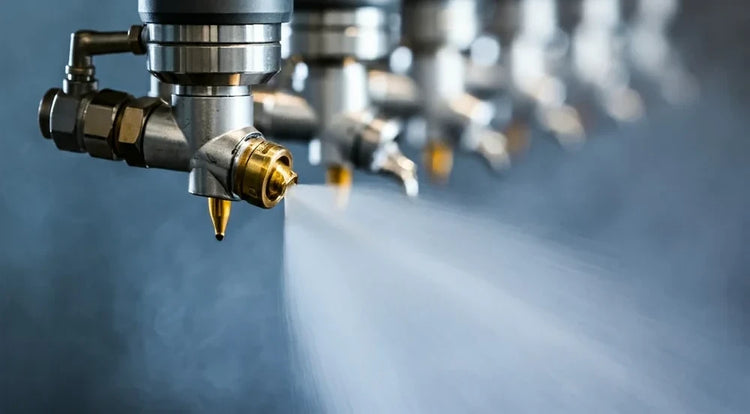Slurry & Ore Washing Nozzles Built for Extreme Durability
Abrasion-resistant nozzles engineered for harsh slurry environments. NozzlePro ceramic orifice and hardened stainless steel nozzles deliver superior TCO (Total Cost of Ownership) through dramatically reduced downtime, extended service life, and clog-free performance in recirculated water systems.
Why Slurry Washing Nozzles Must Be Different
Slurry and ore washing operations present unique challenges that standard industrial nozzles simply cannot survive. High concentrations of abrasive particles—sand, rock fines, mineral solids—flowing through washing systems at high pressure create an environment of constant micro-abrasion that destroys ordinary nozzles within weeks or months.
NozzlePro slurry nozzles are engineered specifically for this harsh reality. Our ceramic orifice, hardened stainless steel, and advanced polymer designs maintain performance where standard nozzles fail, transforming your maintenance costs and operational reliability through dramatically reduced downtime and extended replacement intervals.
Material Selection: Ceramic vs. Hardened Stainless vs. Polymer
Choosing the right nozzle material dramatically impacts service life and total cost of ownership. Understanding the strengths and limitations of each material category is critical for optimizing your slurry system performance.
| Material | Service Life | Cost | Best For |
|---|---|---|---|
| Ceramic Orifice | 12-24 months | $800-1,500 | Maximum abrasion resistance; extreme slurry concentrations |
| Hardened SS 316L | 6-12 months | $400-800 | Excellent balance of durability and cost; most slurry applications |
| Standard SS 316 | 2-6 months | $200-400 | Low abrasion or light-duty slurry operations |
| Tungsten Carbide | 12-18 months | $1,000-2,000 | Ultra-extreme abrasion; specialized applications |
| Advanced Polymer | 3-8 months | $150-300 | Cost-sensitive operations; moderate slurry concentration |
🏆 Ceramic Orifice Nozzles
Material Composition: Alumina or silicon carbide ceramic insert in hardened stainless steel body.
- Hardness: Extreme (2000+ HV); resists abrasion from all mineral compositions
- Service Life: 12-24 months in extreme slurry concentrations
- Best For: High-concentration slurries (30%+ solids), severe abrasion scenarios
- ROI: Highest upfront cost; lowest maintenance frequency = 40-60% TCO reduction vs standard
- Limitations: Brittle if over-pressurized; requires careful handling
⚡ Hardened Stainless Steel 316L
Material Composition: High-carbon, nitrogen-enhanced 316L stainless with hardness optimization.
- Hardness: 450-550 HV; excellent wear resistance with toughness
- Service Life: 6-12 months in moderate-to-high slurry concentrations
- Best For: Most industrial slurry operations (the "goldilocks" solution)
- ROI: Best balance of durability, cost, and TCO across diverse applications
- Advantages: Tolerates over-pressure; handles flow surge better than ceramic
💎 Tungsten Carbide
Material Composition: Tungsten carbide particles in cobalt binder; extreme hardness.
- Hardness: 1400-1600 HV; second only to diamond
- Service Life: 12-18 months in extreme slurry with sand/rock content
- Best For: Ultra-aggressive applications; specialized mining and quarrying
- Cost Consideration: Premium pricing ($1,000+); justified in extreme conditions
- Advantage: Superior to ceramic for certain mineral types (silica-based)
🔧 Standard Stainless Steel 316
Material Composition: Traditional 316 stainless without hardening treatment.
- Hardness: 200-300 HV; standard corrosion resistance
- Service Life: 2-6 months in abrasive slurry (not recommended)
- Cost: Lowest upfront ($200-400); highest replacement frequency
- Use Case: Only in light-duty or low-abrasion applications
- TCO Reality: False economy; 5-6× replacement frequency negates savings
♻️ Advanced Polymer
Material Composition: High-performance engineering plastics with abrasion additives.
- Hardness: 150-250 HV; soft but wear-resistant with lubricity
- Service Life: 3-8 months in moderate slurry concentrations
- Advantage: Very low cost; easier on equipment if misapplied
- Limitation: Cannot handle high pressure or hot slurries
- Best Use: Temporary installations or budget-constrained operations
ROI Calculator: Reduce Downtime in Slurry Operations
Understand exactly how much you can save by upgrading to slurry-rated nozzles. Enter your current metrics and see the financial impact:
💰 Total Cost of Ownership Calculator
Slurry & Ore Washing Applications
NozzlePro slurry nozzles are engineered for demanding ore processing and mineral washing environments:
🪨 Ore Washing Screens
High-impact jets remove clay and fines from ore on vibrating screens. Ceramic or hardened SS handles sand recirculation. View cleaning solutions →
🔄 Log Washers & Trommel Screens
Continuous spray on rotating equipment requires extreme durability. Slurry-rated nozzles withstand hours-long operation without failure. Hardened SS316L ideal for this application.
💧 Recirculation Systems
Filtered but still abrasive recirculated water challenges standard nozzles. Clog-free design handles sediment in return water. Dramatically extends wash water life with mineral recovery.
🏭 Hydrocyclone Discharge
Spray wash after hydrocyclone for fine-particle recovery. High-pressure, abrasive environment demands ceramic or tungsten carbide. ROI calculator shows 12-month break-even.
⛏️ Mining Pit Dewatering
Wash recovered solids from pit dewatering circuits. Slurry-rated nozzles maintain performance where standard nozzles fail weekly. Critical for minerals recovery economics.
🌊 Settling Pond Management
Agitate and resuspend settled fines for recovery. Extreme slurry concentration demands ceramic orifice for 12+ month service intervals. Operating cost reduction transforms project economics.
TCO Benefits of Premium Slurry Nozzles
Dramatically Extended Service Life – Ceramic 12-24 months vs standard 2-4 weeks = 60-90% fewer replacements annually
Reduced Operational Downtime – Fewer replacement cycles = less equipment downtime = higher throughput and revenue
Clog-Free Performance – Premium materials + optimized orifice design handle recirculated water without blockages
Superior Material Recovery – Consistent spray performance maximizes fines capture in recirculation systems
Lower Total Cost of Ownership – Premium upfront cost amortized over 12+ months service life = 40-60% cost reduction
Predictable Maintenance Costs – Scheduled replacements vs emergency failures = better budget planning and supply chain management
Slurry Nozzle Technical Specifications
Performance characteristics optimized for abrasive slurry environments:
| Specification | Value | Impact on Performance |
|---|---|---|
| Orifice Hardness | 400-550 HV (standard) | Ceramic: 2000+ HV; tungsten carbide: 1400-1600 HV for superior abrasion resistance |
| Orifice Geometry | Optimized for slurry | Larger internal passages prevent fines accumulation; smooth transitions reduce turbulence |
| Operating Pressure | 5 – 100 bar | Higher pressure increases impact force but accelerates wear; find sweet spot for your slurry type |
| Flow Rate Range | 0.5 – 300+ LPM | Select based on wash water volume and coverage requirements; larger orifices tolerate fines better |
| Thread Sizes | 1/4" – 1" | Standard NPT/BSP/BSPT; larger threads support higher flow without pressure drop |
| Spray Patterns | Full cone, hollow cone, flat fan | Full cone for uniform coverage; flat fan for edge-to-edge washing; pattern choice affects durability |
How to Select Slurry Nozzles: Step-by-Step
Choosing the right nozzle material and specification requires understanding your specific slurry composition and operation:
- 1. Characterize Your Slurry: Identify solid concentration (% by weight), particle size distribution, and mineral composition. Sand/silica? Hard rock? Iron ore? Material type affects wear rate dramatically.
- 2. Assess Current Performance: How long do existing nozzles last? 2 weeks? Monthly? This baseline determines upgrade strategy and ROI timeline.
- 3. Calculate Downtime Cost: What is the cost of 1 hour production downtime? 10 nozzle replacements per year × 2 hours each × your hourly cost = true operational cost of failures.
- 4. Select Material Based on Use: Ceramic for highest durability if downtime cost justifies premium; hardened SS316L for best balance; standard SS only for low-concentration applications.
- 5. Specify Spray Pattern: Full cone for uniform washing; flat fan for impact cleaning; hollow cone for light coverage.
- 6. Consider Recirculation: Filtered recirculated water still carries fines—nozzles must tolerate partial clogging risk. Specify clog-resistant designs or larger orifices.
- 7. Factor Maintenance Access: Can operators replace nozzles quickly? Position nozzles for easy removal or specify quick-disconnect headers to reduce labor costs.
Slurry System Solutions
Complete your slurry operation with complementary NozzlePro solutions:
Cleaning & Washing Nozzles
Full range of spray patterns for ore processing. View cleaning solutions →
Full Cone Spray Nozzles
Slurry-rated full cone for uniform coverage washing. Explore full cone →
Flat Fan Spray Nozzles
Impact cleaning on screens and surfaces. Browse flat fan →
High-Pressure Nozzles
For aggressive slurry washing and descaling. View high-pressure →
Tungsten Carbide Nozzles
Ultra-extreme durability for severe abrasion. See tungsten carbide →
Tank & Sump Cleaning
Clean washing tank and slurry sumps. View tank cleaning →
Frequently Asked Questions About Slurry Nozzles
Why do standard nozzles fail so quickly in slurry applications?
What's the difference between ceramic and tungsten carbide for slurry?
How do I prevent clogging in recirculated wash water?
Is hardened SS316L better than ceramic for my application?
What pressure should I run slurry nozzles at?
How do I calculate ROI on upgrading from standard to premium nozzles?
Transform Your Slurry Washing Economics
NozzlePro slurry nozzles dramatically reduce downtime and maintenance costs through superior durability. Ceramic orifice, hardened stainless steel, and tungsten carbide options engineered for mining and aggregate operations. Calculate your ROI above, then contact our slurry specialists to design your optimized system.

